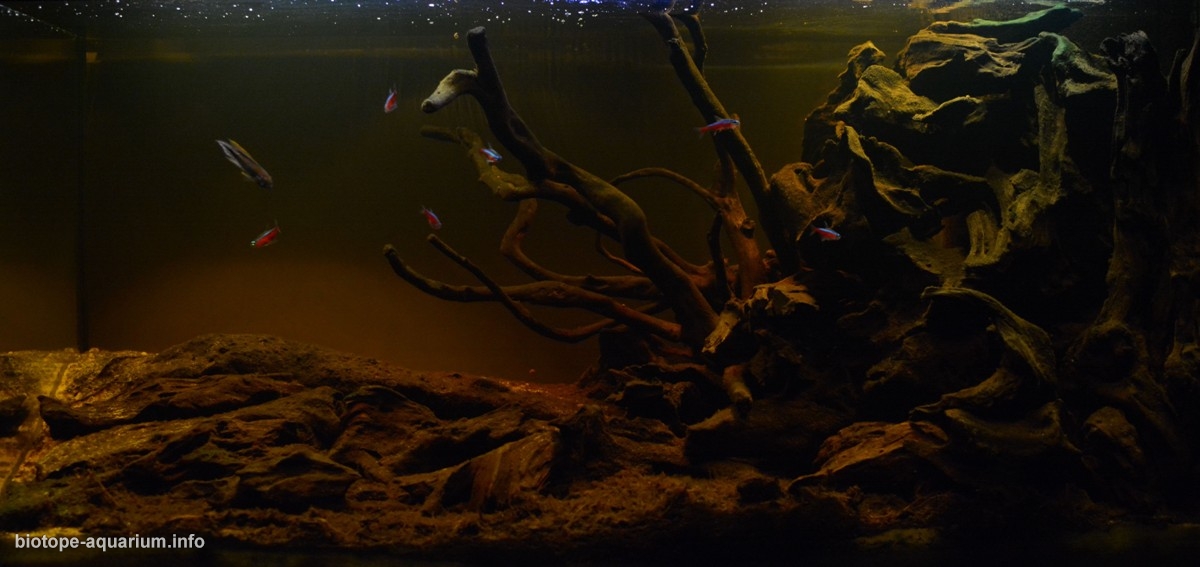Small creek in Rio Negro system, Amazonas state, Brazil
78th place in Biotope Aquarium Design Contest 2019
Poland. Arkadiusz Skrzycki

Volume: 112 L
Dimensions: 80x35x40 cm
List of fishes: Paracheirodon axelrodi, male apistogramma agassizi transferred from the spawning aquarium, because he ate young commas after a few days after hatching.
List of plants: N/A
Description of decorations: The substrate is fibrous peat on it fine sand from the river covered with a large amount of decaying leaves and peat. The roots used for decoration come from peat bogs. The appearance of my aquarium of the black waters of South America, despite the constant decor, is variable. By periodically adding leaves and peat, its appearance changes every few weeks, additionally the light operating in 24h mode causes that our underwater world can still delight us.
Description of equipment: The Hamburg filter is located in the rear of the aquarium and is powered by the aquael 500 circulator, which is set to minimum efficiency. The lighting consists of a 150 W radiator. The lighting consists of 0.75W LED modules each: 4x3000K, 4x8000K, 2x blue and 5x11000K, controlled by dawn controller – twilight TC 421, which gives the possibility to use 5 channels (sections) which also I did.
Water parameters: The water temperature is 25 ° C, the water color can be compared to the tea color pH 5.6, KH and GH unmeasurable, TDS 36 ppm.
Additional info: This is the continuation of “Small Creek in the Rio Negro system, Amazonas state, Brazil” from the previous year’s contest. The arrangement was changed, and I left only the small schools of Paracheirodon axelrodi, recently the male Apistogramma agassizi entered the cast due to the spawning he had just carried out (previous spawning was eaten by him) and I had to move him to another tank.
INFORMATION ABOUT BIOTOPE
Description of the area surrounding the biotope: Black water of South America is primarily a landscape of sand covered with tangles of roots, leaves, algae and fish perfectly adapted to this difficult environment. The water is tea color, barren and very sour. They are part of the great Amazonian basin water system.
The forest surrounding this small river reflects many organic substances. These are primarily leaves and fruits falling from trees and rinsed during the rainy season, as well as roots and broken branches. They rot and give off tannins and humic acids – substances that strongly acidify and color brown water. The bottom of the water reservoirs is usually sandy but covered with a thick (20-30 cm) layer of rotting plant particles. There is a lot of decayed wood in the water. The biotope of black waters includes both running and standing tanks. The first of these is usually slowly flowing river. These include, for example, Rio Negro, Rio Cururu, Rio Arapiuns, Rio Tefe and their tributaries. Black water also occurs in bays and small storages surrounded by jungle.
Description of the underwater landscape of the biotope: Small Igrape belonging to the black waters of the Rio Negro basin near Barcelos do Rio Negro, Dept. Amazonas near 63.04’W / 0.01’S, sometimes referred to by local inhabitants of Rio Salgado. There are a lot of trees, the roots of the leaves, and the fruits cover the bottom of the tank, giving the fish plenty of hiding places and food.
Description of the parameters of the habitat: The light entering the water is limited by branches of trees growing on the shore. The color of the water give the tannins is dark brown and very transparent up to 3 meters. The water is acid and barren. The average temperature in the rainy season is 23 ° C and lasts from September to May, the pH is 6. The remaining months are dry season and the average temperature is between 28-30 ° C, while the pH is very acidic up to 3.5.
List of fishes and invertebrates occurring in the nature biotope: Paracheirodon axelrodi, Nannostomus unifasciatus, Nannostomus eques, Hemigrammus sp., Dicrossus filamentosus, Apistogramma mendezi, Poecilocharax weitzmani, Crenicichla notophthalmus, Crenicichla marmorata.
List of plants found in the nature biotope: water plants do not occur, periodically in the rainy season flooded plants.
Threats to the ecology: Threats for this biotope are a mass section of the forest, and gold mines on rivers of the Amazon.
Sources of information:
http://www.tfhmagazine.com/
http://www.reef2rainforest.
http://www.seriouslyfish.com/
https://weatherspark.com/y/
http://www.apisto.pl/index.
https://www.fishbase.de/
https://www.researchgate.net/
